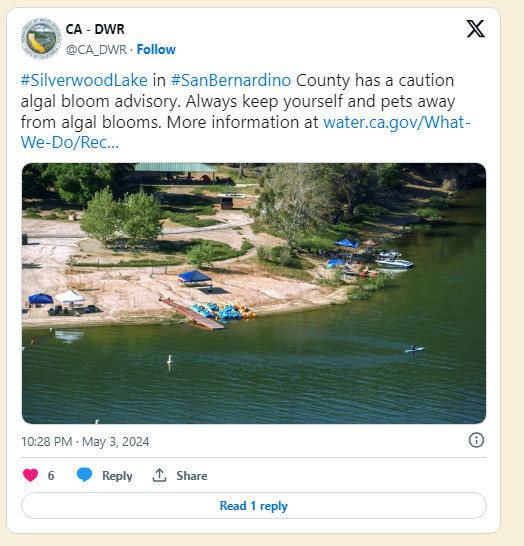
California water officials are issuing a cautionary alert, urging residents and their pets to steer clear of Silverwood Lake in San Bernardino County following the detection of a toxic algal bloom in the reservoir.
The Department of Water Resources has sounded the alarm, advising people to avoid certain areas of the popular recreational site until further notice due to the presence of harmful cyanobacteria, commonly known as blue-green algae, in the water.
While blue-green algae are a natural component of many ecosystems, they can proliferate rapidly, forming what is referred to as a “bloom,” particularly under specific conditions such as warmer water temperatures. Experts highlight that this issue is escalating as a result of climate change, aging water infrastructure, and human activities converging in water bodies across the state.
West Bishop, an algae scientist and research manager at the water quality restoration company Eutrophix, underscored the adaptability of cyanobacteria, attributing their proliferation to factors such as rising global temperatures, increased carbon dioxide levels, and UV light penetration. He also pointed out that nutrient accumulation, particularly phosphorus from sources like agricultural runoff, leaky septic systems, and stormwater drainage, can fuel these blooms.
The health hazards associated with exposure to harmful algal blooms include eye irritation, skin rashes, mouth ulcers, gastrointestinal distress, and flu-like symptoms. Pets are particularly vulnerable as they may ingest contaminated water or lick it off their fur.
“The advisory is crucial to safeguard the health and safety of park visitors and pets,” emphasized the Department of Water Resources regarding Silverwood Lake. “While swimming is permitted, visitors are cautioned to avoid algae and scum in the water or on the shore. Pets should not be allowed to enter the water or consume algae.”
This is not the first instance of Silverwood Lake being affected by harmful blooms. Similar warnings have been issued in recent months, including November 2022 and August 2023. The age of the reservoir also contributes to the problem, as nutrients can accumulate over time, fostering the resurgence of blooms.
Moreover, Silverwood Lake’s treatment with copper sulfate on Tuesday aims to curb the algal bloom. Despite this intervention, the caution advisory will remain until toxin levels diminish to a safe threshold.
The Department of Water Resources assures that drinking water quality will not be compromised by the treatment, as copper sulfate is approved for use in water supply reservoirs. Furthermore, ongoing testing and health advisories will persist until the harmful algal bloom subsides.
As precautionary measures, residents are advised to refrain from swimming, wading, and engaging in water sports in affected water bodies. Additionally, shellfish consumption from contaminated waters should be avoided, and thorough cleaning of fish caught from these areas is recommended. Immediate medical attention is warranted in case of exposure to harmful blooms.
With the potential risks posed to both humans and wildlife, heightened vigilance and adherence to safety advisories are paramount to mitigate the impact of these toxic algal blooms.



















